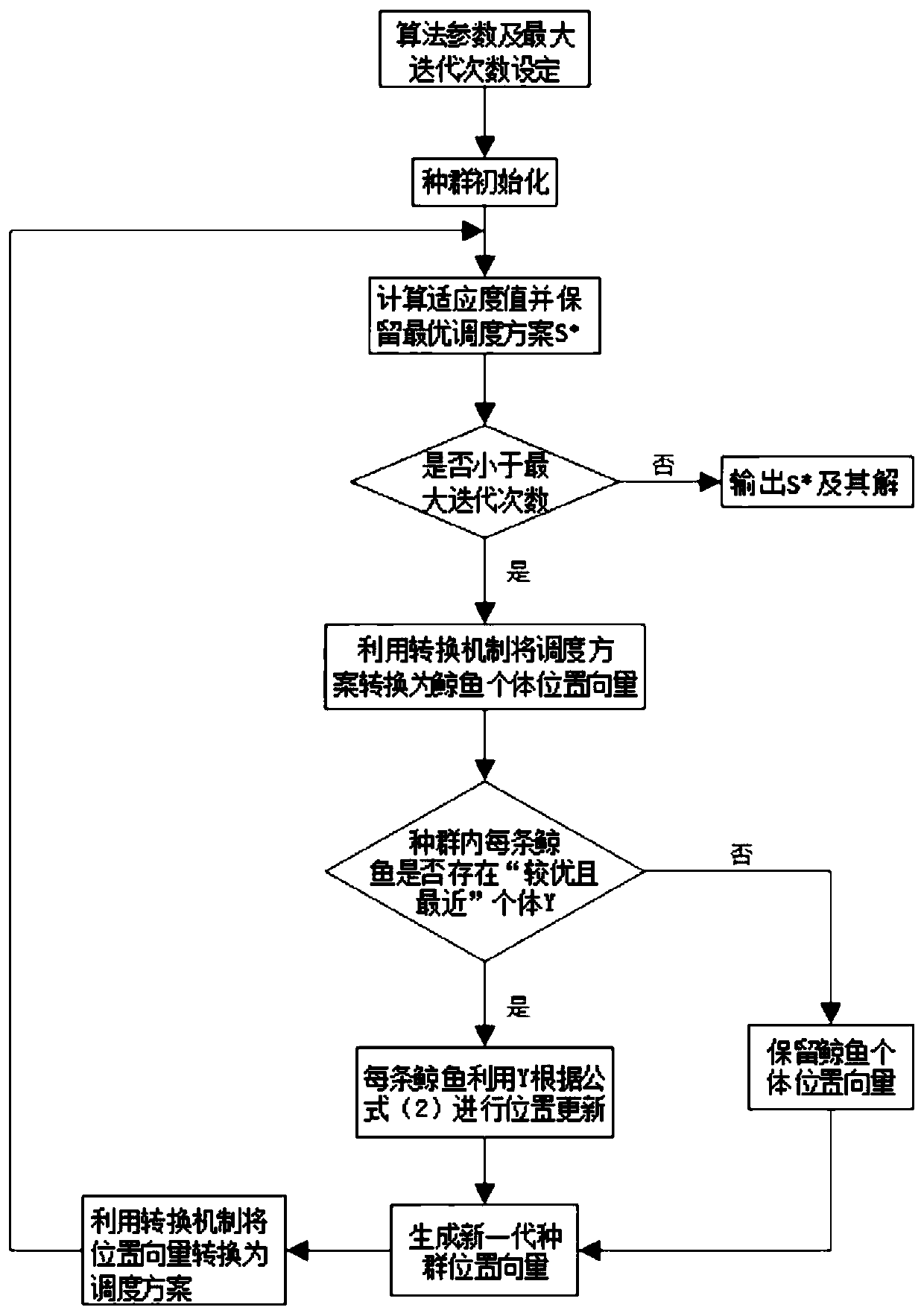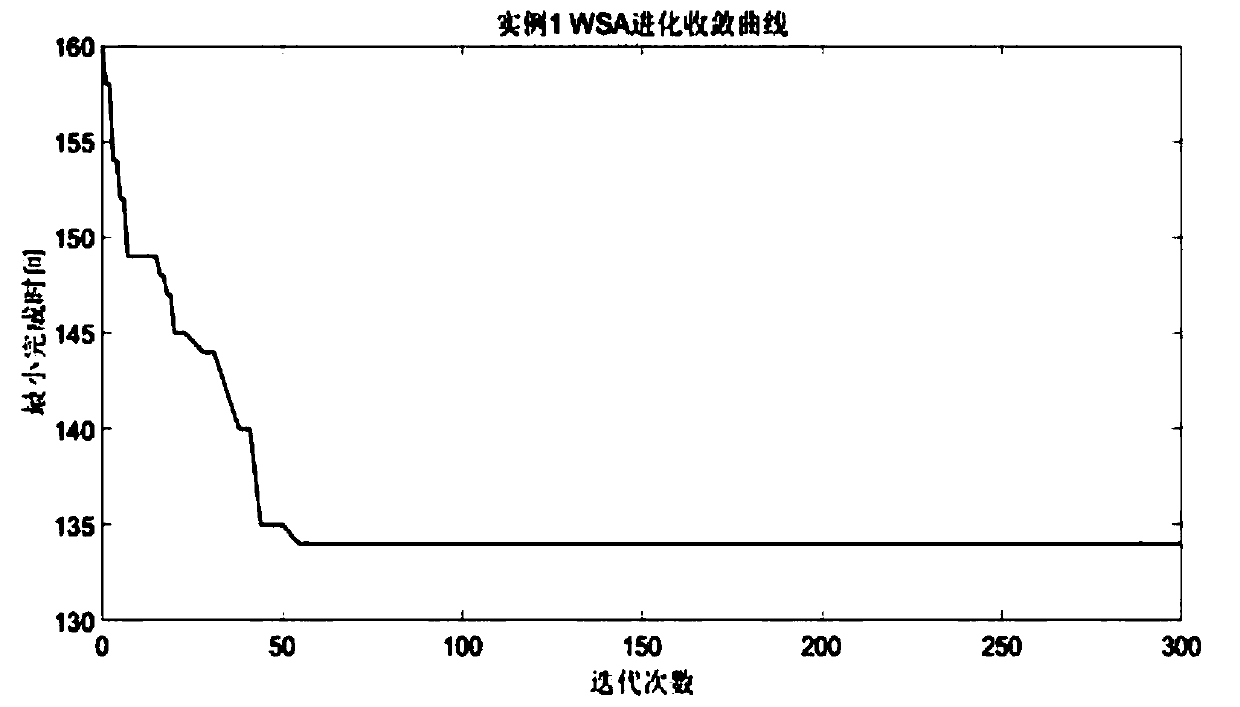A method for solving flexible job shop scheduling based on a hybrid whale swarm algorithm
A technology of flexible operation and workshop scheduling, applied in computing, computing models, instruments, etc., can solve problems such as slow convergence speed and low solution accuracy
- Summary
- Abstract
- Description
- Claims
- Application Information
AI Technical Summary
Problems solved by technology
Method used
Image
Examples
example 1
[0117] Example 1 is a 3×6 FJSP, and its processing task information is shown in Table 1. The parameters of the whale swarm algorithm are set as follows: the population size is 50, the dimension of the individual whale position vector is 30, ρ 0 set to 2, d max =32.86, the attenuation coefficient η is set to 0, and the maximum number of iterations M is 400:
[0118] Table 1 Example 1 processing task information table
[0119]
[0120] Use two-stage encoding based on random keys to encode machine allocation and process sequencing, then the length of the individual position vector is 30, and each element can take any value in [-3,3], use a computer to generate a 30-bit random number, and stored in a certain order, as shown in Table 2, where OP ij Indicates the jth process of workpiece i:
[0121] Table 2 Individual position vector map
[0122]
[0123] For embodiment 1, its WSA evolution convergence curve obtained by solving it is as follows figure 2 shown by figure...
Embodiment 2
[0125] In order to further verify the feasibility and superiority of the algorithm, select literature [1] (Fu Weiping, Liu Dongmei, Lai Chunwei, Wang Wen. Improved genetic algorithm based on multi-color set to solve multi-variety flexible scheduling problem[J]. Computer Integrated Manufacturing System, 2011 ,17(05):1004-1010.) to carry out the simulation, the specific processing information can be found in literature [1]. The parameters of the whale swarm algorithm are set as follows: the population size is 100, and the dimension of the individual whale position vector in example 1 is 108, ρ 0 set to 2, d max =104.96, the attenuation coefficient η is set to 0, and the maximum number of iterations M is 200. The evolutionary convergence curve of WSA is obtained as Figure 4 As shown, the optimal solution is 121 minutes, by Figure 4 Comparing the evolutionary convergence curve of WSA with the evolutionary curve of Example 2, it can be seen that the whale swarm algorithm can q...
Embodiment 3
[0127] In order to compare and verify the effect of the algorithm more comprehensively, the 8×8 embodiment in the Kacem benchmark problem of flexible job scheduling is selected to solve, and the calculation is performed 20 times. The parameters of the whale swarm algorithm are set as follows: the population size is 100, the dimension of the individual whale position vector is 54, ρ 0 set to 2, d max =117.57, the attenuation coefficient η is 0, and the maximum number of iterations M is 200, the WSA evolution convergence curve of embodiment 3 is as follows Figure 5 shown. Table 3 compares the results obtained by the whale swarm algorithm with the results obtained by the evolutionary algorithm, master-slave genetic algorithm, multi-stage genetic algorithm, and ant colony algorithm:
[0128] Table 3 Comparison of solution results of various algorithms for the Kacem 8×8 benchmark problem
[0129] method name
[0130] Aiming at the shortcomings of the traditional algor...
PUM
 Login to View More
Login to View More Abstract
Description
Claims
Application Information
 Login to View More
Login to View More - R&D
- Intellectual Property
- Life Sciences
- Materials
- Tech Scout
- Unparalleled Data Quality
- Higher Quality Content
- 60% Fewer Hallucinations
Browse by: Latest US Patents, China's latest patents, Technical Efficacy Thesaurus, Application Domain, Technology Topic, Popular Technical Reports.
© 2025 PatSnap. All rights reserved.Legal|Privacy policy|Modern Slavery Act Transparency Statement|Sitemap|About US| Contact US: help@patsnap.com



